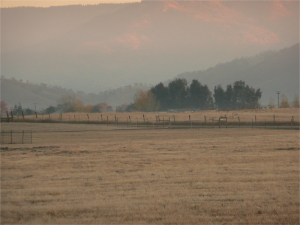
I am fortunate to live in California’s vast and beautiful Central San Joaquin Valley and foothill region – close to nature, immersed in inspiration. I paint to convey my intuitive sense about life. As I contemplate the mystery of things becoming, I am intrigued by the fleeting relationship between the observer and the observed. Paradoxically, the call to visually express form and formlessness demands a particular shape. The essence of form is its ethereal counterpart–the very idea that brought it into being. Water, as a metaphor, simply expresses these ideas. It is both a shape shifter and a mirror. As such, it is a subject in which I find exquisite beauty and space to roam. Within water I find color and no color. Form and no form. Depth and no depth.
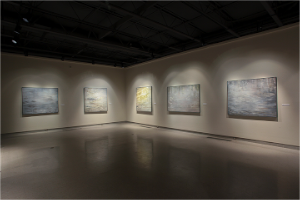
Edges: an investigation, January - April 2012
Fresno Art Museum
The idea of the edge has long challenged artists, who seek to express the paradigm of our visual world. As distinctions between objects in space, the human eye seeks edges to understand where one thing begins and another ends. Human perception of the visual edge is a collaborative effort demanding the physics of eyesight, one's physical environment and the presence of light. This collaboration is a conspiracy, of sorts, influenced by a host of inescapable factors: psychological, cultural and physiological. Because the very idea of an edge is open to debate and hard to pin down, the realm of optical illusions exists. An artist's edge may indicate a boundary, a threshold, a pathway . . . expressed as a line, a form, or a shadow–hard-edged or barely perceptible. Edges may be created, dissolved, merged, expanded, sharpened, dulled, or disregarded. In this exhibit, California Contemporary Art Collective artists focus on the concept of how edges define or play into their work.
Fresno Art Museum
The idea of the edge has long challenged artists, who seek to express the paradigm of our visual world. As distinctions between objects in space, the human eye seeks edges to understand where one thing begins and another ends. Human perception of the visual edge is a collaborative effort demanding the physics of eyesight, one's physical environment and the presence of light. This collaboration is a conspiracy, of sorts, influenced by a host of inescapable factors: psychological, cultural and physiological. Because the very idea of an edge is open to debate and hard to pin down, the realm of optical illusions exists. An artist's edge may indicate a boundary, a threshold, a pathway . . . expressed as a line, a form, or a shadow–hard-edged or barely perceptible. Edges may be created, dissolved, merged, expanded, sharpened, dulled, or disregarded. In this exhibit, California Contemporary Art Collective artists focus on the concept of how edges define or play into their work.
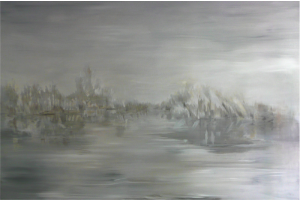
Dawn on The San Joaquin, October 2011
Experiencing the San Joaquin River, at daybreak, inspired this series of paintings, which presents views ranging from close-ups to distant panoramas. A particularly rainy winter and spring, in 2011, offered much in the way of atmosphere and a dazzling array of grays. I look forward to another moody fall and winter as I continue to paint this series.
Experiencing the San Joaquin River, at daybreak, inspired this series of paintings, which presents views ranging from close-ups to distant panoramas. A particularly rainy winter and spring, in 2011, offered much in the way of atmosphere and a dazzling array of grays. I look forward to another moody fall and winter as I continue to paint this series.
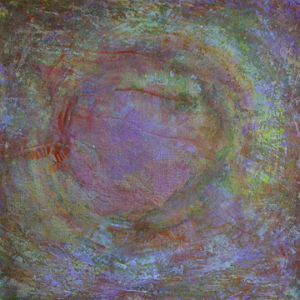
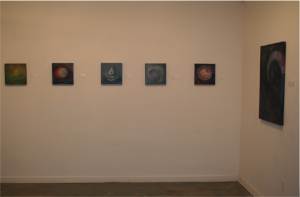
Phases of the Moon, February 2009
Phases of the Moon reflects my 5-week journey, in the winter of 2007, through the Kingdom of Nepal. Here, the peaks of the Himalayas reach the highest points on earth. The Nepalese and Tibetans have long recognized the significance of living close to the heavens and Hindu and Buddhist cosmology is deeply imbued with sky-touching symbolism as a metaphor for reaching enlightenment.
In Nepal, carved crescent moons are seen everywhere: mounted on temples, shrines, rooftops, arches, columns, monastery gates, doorways, windows, billboards – all things that touch the sky. The crescent is often balanced on its curved apex–like a big bowl poised to catch the stars – a striking image that also appears with a sphere (or full moon) resting inside its arc.
In garden design, crescent-shapes are carved into lawns and thoughtfully positioned in relation to one another relative to the architecture of the buildings or monuments surrounding them. Crescent moon gardens, planted with nothing but white flowers, reflect the light of the full moon in a beautifully simple way.
The moon's importance in Nepal becomes even more profound when one considers the kingdom follows a lunar calendar. The number of days in a month is never constant thus birthdays and anniversary dates shift from year to year and festival and wedding dates are determined only after complex astrological calculations. The uncertainty of such a system is part of the culture's mystique, and in fact driving into Katmandu one passes beneath a large banner welcoming visitors to the "Mystical and Magical Nepal."
Back home, in the studio, crescents and spheres emerged from my canvasses. As a painter, I've long dwelled upon the idea of things becoming . . . of forms emerging from a vast space and receding back into nothingness – like the cycles of the moon – appearing in and disappearing from our field of vision. As shapes rise to the surface, I feel the pull of the moon and recognize its influence on my language and my inquiry into the ephemeral relationship between the observer and the observed.
Phases of the Moon reflects my 5-week journey, in the winter of 2007, through the Kingdom of Nepal. Here, the peaks of the Himalayas reach the highest points on earth. The Nepalese and Tibetans have long recognized the significance of living close to the heavens and Hindu and Buddhist cosmology is deeply imbued with sky-touching symbolism as a metaphor for reaching enlightenment.
In Nepal, carved crescent moons are seen everywhere: mounted on temples, shrines, rooftops, arches, columns, monastery gates, doorways, windows, billboards – all things that touch the sky. The crescent is often balanced on its curved apex–like a big bowl poised to catch the stars – a striking image that also appears with a sphere (or full moon) resting inside its arc.
In garden design, crescent-shapes are carved into lawns and thoughtfully positioned in relation to one another relative to the architecture of the buildings or monuments surrounding them. Crescent moon gardens, planted with nothing but white flowers, reflect the light of the full moon in a beautifully simple way.
The moon's importance in Nepal becomes even more profound when one considers the kingdom follows a lunar calendar. The number of days in a month is never constant thus birthdays and anniversary dates shift from year to year and festival and wedding dates are determined only after complex astrological calculations. The uncertainty of such a system is part of the culture's mystique, and in fact driving into Katmandu one passes beneath a large banner welcoming visitors to the "Mystical and Magical Nepal."
Back home, in the studio, crescents and spheres emerged from my canvasses. As a painter, I've long dwelled upon the idea of things becoming . . . of forms emerging from a vast space and receding back into nothingness – like the cycles of the moon – appearing in and disappearing from our field of vision. As shapes rise to the surface, I feel the pull of the moon and recognize its influence on my language and my inquiry into the ephemeral relationship between the observer and the observed.
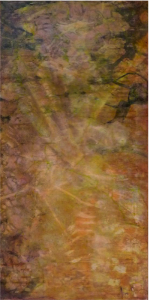
B. Heffron Collection
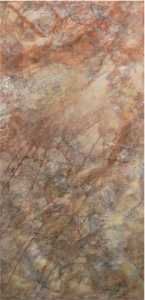
from the series Dusk on Lucy's Pond, # 7
Private Collection
Dusk on Lucy's Pond, November 2008
I like to imagine dusk as an atmospheric fold that offers the day its final bow before the evening curtain. Contrasts blur, shadows converge, colors soften. Dusk is my favorite time of day particularly when I am near a body of water.
Finegold Creek twists and turns through the Sierra Nevada foothills of central California. Exhilarating in winter and quietly still during the smouldering days of August, the creek ebbs and flows with the seasons producing thundering white-waterways, icy-cold waterfalls, ribbon-thin streams and smooth quiet pools.
One of these pools is Lucy’s Pond – a pond held in the hands of massive granite boulders and millions of cattails rooted in rich creek silt. Lush woodlands of oak, redbud, river willow and evergreen reflect into the cold mountain water – clear water that curls around broad flat rocks that beg you to lie down and do nothing.
Points of View on the Pond
These paintings were inspired by simply gazing down into the water directly beneath me and letting it take me away . . . drinking in swirling patterns of light, color, shadow and sound. Light reflecting on an undulating medium and refracted light bending through the water's depths can fool the eye.
In this orchestrated chaos of shifting patterns, I noticed that concentric rings of water retain their shape as they expand outward and cross paths with one another, becoming complex Tartan plaids before they fade to nothingness. Mesmerized by this phenomenon, I lost all sense of subject and ground. I’ve rendered these paintings without reference points to land, horizon or reflected objects. With no sharp delineations between sky, water and surface, the perspective suggests an undulating flatness only intensified by the time of day.
One may choose how to look: skimming the surface, diving down deep, swimming toward the pale light from above floating horizontal to the creek bed, or slowly exploring the pond's murky depths and underwater caves. With a relaxed eye many paintings reveal several perspectives simultaneously.
I like to imagine dusk as an atmospheric fold that offers the day its final bow before the evening curtain. Contrasts blur, shadows converge, colors soften. Dusk is my favorite time of day particularly when I am near a body of water.
Finegold Creek twists and turns through the Sierra Nevada foothills of central California. Exhilarating in winter and quietly still during the smouldering days of August, the creek ebbs and flows with the seasons producing thundering white-waterways, icy-cold waterfalls, ribbon-thin streams and smooth quiet pools.
One of these pools is Lucy’s Pond – a pond held in the hands of massive granite boulders and millions of cattails rooted in rich creek silt. Lush woodlands of oak, redbud, river willow and evergreen reflect into the cold mountain water – clear water that curls around broad flat rocks that beg you to lie down and do nothing.
Points of View on the Pond
These paintings were inspired by simply gazing down into the water directly beneath me and letting it take me away . . . drinking in swirling patterns of light, color, shadow and sound. Light reflecting on an undulating medium and refracted light bending through the water's depths can fool the eye.
In this orchestrated chaos of shifting patterns, I noticed that concentric rings of water retain their shape as they expand outward and cross paths with one another, becoming complex Tartan plaids before they fade to nothingness. Mesmerized by this phenomenon, I lost all sense of subject and ground. I’ve rendered these paintings without reference points to land, horizon or reflected objects. With no sharp delineations between sky, water and surface, the perspective suggests an undulating flatness only intensified by the time of day.
One may choose how to look: skimming the surface, diving down deep, swimming toward the pale light from above floating horizontal to the creek bed, or slowly exploring the pond's murky depths and underwater caves. With a relaxed eye many paintings reveal several perspectives simultaneously.